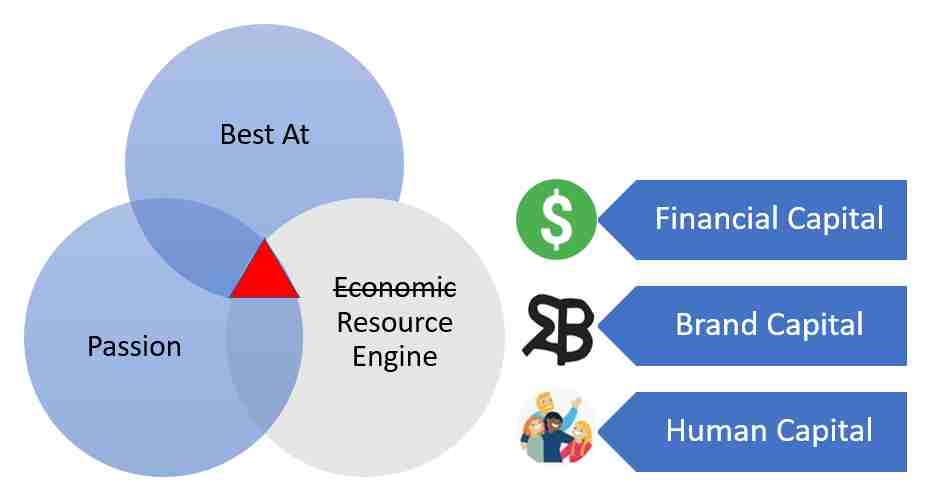
I could not let the series based on Jim Collins’s book “Good to Great” pass without addressing a hole the author acknowledges related to what he defines as social sector organizations. Two key areas where a social sector enterprise breaks from the book’s ideas are related to the hedgehog concept and leadership.
One of the three circles that make up the hedgehog concept is called the Economic Engine. If people do not pay an enterprise for a product or service, how can the organization define its economic denominator as profit per X? Since profit is not the focus of social sector organizations, the tenon of the book that deals with your economic engine must be redefined into something meaningful based on the organization’s mission. Moreover, what Jim calls level five leadership is very different in a mission-driven organization, which requires leaders to have more legislative or political skills than in a profit-driven organization, which requires more executive skills in their leader.
What is a Social Sector Organization?
The term social sector organization is not very well defined. In researching this post, I found many conflicting definitions. Therefore, I’ll offer my own definition, not to add to the confusion but to create a common understanding for the rest of this post. I offer that
“A social sector organization is simply an enterprise that has specific social objectives as their primary purpose rather than making a profit.”
Steve Imke
According to the renowned economist Milton Friedman, “The sole purpose of a business is to generate profit for its shareholders.” also known as the Friedman doctrine Of course, he was talking about a for-profit business. While a for-profit business exists to return a profit for its investors, be it for the solopreneur or shareholders in a corporation, a social sector organization looks at money not as an output to measure success but as an input to fund its operations so it can deliver on its mission.
I volunteer my time to share my business acumen with clients of two organizations, SCORE and the SBDC which are social sector enterprises. Both of their missions are to help entrepreneurs succeed in starting and operating a small business, which is a cause I care deeply about. Their missions are not focused on making a profit but on creating a vibrant entrepreneurial ecosystem. The money they receive to fund their operations is an input to provide the resources necessary to deliver on their mission and not an output used to define their success.
The Hedgehog Concept Revisited for the Social Sector
The hedgehog concept is based on three interrelated circles: 1. what is the one thing you can be better at than anyone else, 2. what lights your passion, and 3. your economic engine. The problem with a social sector enterprise is that the economic engine is not driven by earning a profit. Instead, in a social sector organization, the ultimate goal of earning a profit is replaced by accomplishing a mission. To address this issue, social sector enterprises need to replace the economic engine circle with a Resource Engine circle because it will require these resources to fulfill its mission.
Many social sector leaders have asked Jim to help them define the attributes that make up their resource engine. To that, Jim has shared that a social sector organization needs to examine three resources: financial brand, and human.

Financial Capital
As we stated above, a key difference between a for-profit and a social sector organization is the role money plays. In a for-profit business, money is how it keeps score and measures success. Money, or more accurately profit, is the result of the business’s labor. For a social sector enterprise, money is the input that allows it to perform its mission and not the output used to measure success. When it comes to social sector organizations, any discussion about money is focused on the fuel to keep the engine going.
Social sector enterprises get funds to operate from three primary sources, government, charitable contributions, and by generating their own revenue. Each social sector organization is likely to receive funding from one or a combination of these three sources or what we could call a hybrid funding source. Let’s examine each category of funding in a bit more detail.
Government-Funded Organizations
Heavily government-funded organizations as their name implies are funded principally by the allocation of tax dollars. NASA, military branches, public schools, as well as police and fire departments fall into this category. They are provided a budget to cover the cost of their operations so they can complete their assigned mission. At the end of each year, legislators look at the organization’s performance and adjust their budget for the following year. Funding is very predictable, at least in one-year increments. While organizations in this category may obtain funding from other sources, such as selling their services, the primary source of revenue comes from the government.
The two organizations to which I volunteer my time and energy, SCORE and the SBDC, get most of their annual funding from an SBA allocation. In the case of the SBDC, they get a match from other government organizations such as the city or county governments. To say that the SBDC is better funded than SCORE is an understatement. Both organizations also obtain funding to exercise their mission by selling low-cost training. In the case of SCORE that receives significantly less funding, tuition fees from teaching business courses make up a larger share of their overall annual funding compared to the SBDC that gets most of its funding from government allocations. Therefore, I would classify the SBDC as heavily government-funded while SCORE would be more of a hybrid-funded organization.
The kinds of leaders that are successful in social sector enterprises funded primarily through government sources are leaders with excellent political or legislative skills to maintain public support for the organization, rather than the executive skills more common in for-profit businesses.
Charity-Supported Organizations
Heavily charity-supported organizations are cause-driven and depend primarily upon charitable contributions from private individuals to fund their operations. Many charity-supported organizations are organized as non-profits so that the donor can write off their donations. Organizations such as the American Cancer Society or Habitat for Humanity as well as many religious institutions are funded primarily through donations from individuals.
Relying strictly on charitable contributions means this social sector category has to spend a significant amount of its energy on fundraising activities to ensure they have the operating income to fund their mission. As a result, some charity-supported organizations seek to be the recipient of legacy gifts when a wealthy person passes, in order to create endowments funds whose returns can be used to provide a more consistent source of funding to augment their more fluctuating charitable contributions.
The kinds of leaders that are successful in social sector enterprises that are funded primarily through charitable contributions are leaders that are excellent at developing personal relationships and excel in fundraising.
Revenue Supported Organizations
Heavily revenue-supported organizations rely on generating their own revenue streams, most often from users, to fund their operations. Organizations in this category fund themselves primarily through fees charged for products, services, tuition, or contracts.
Organizations such as nonprofit hospitals and institutions of higher education sell their services directly to the consumer to generate the funds to support their organization’s operations. Other revenue-supported organizations use donations that they sell to generate the funds necessary to fund their mission’s operating costs. Organizations such as the Red Cross sell donated blood products, while organizations like Goodwill or the ARC, where I was their treasurer for five years, sell donated household goods through their thrift stores to generate the funds needed to support their mission.
The kinds of leaders that are successful in social sector enterprises funded primarily through activities that generate revenue are leaders with excellent executive skills often found in for-profit businesses.
Hybrid Supported Organizations
Hybrid supported organizations do not rely on a single primary source of funding and instead, blend government funding, charitable donations, and organizational revenues. Performing arts organizations often receive funding from local government in the form of hotel or tourism taxes, donations from private donors, and the sale of tickets to performances.
Organizations such as your local boys and girl scouts’ counsels get funding from their national affiliation, conduct fundraising activities such as selling cookies to generate donations, collect registration fees from users and sell uniforms and equipment. Many hybrid-supported organizations also benefit from corporate sponsorships. For example, to fund the Olympics, the organizers receive funding from event ticket sales, broadcast rights, corporate sponsorships, as well as from governments.
The kinds of leaders that are successful in social sector enterprises that are funded through a hybrid funding mechanism are leaders with a high degree of business acumen and fundraising skills.
Brand Capital

I once heard someone say that it is called branding because, just as you can brand a cow with a letter or a shape, your enterprise’s branding efforts are designed to burn your organization’s image and reputation into someone’s brain. This goes double for social sector enterprises who rely on the organization’s brand to gain support.
Branding is emotional and as a social sector organization, you must tap into people’s emotions to maintain public support for your mission. Your brand is your reputation to do what you say that you will do. With a weak brand, you will not be able to create the gravity necessary to recruit donors and the human capital to deliver on your mission.
For example, whenever there is a natural disaster, be it a major earthquake, hurricane, or flooding anywhere on the globe, what brand comes to mind? For most people, it is the Red Cross. The Red Cross has spent years cultivating that brand, making people willing to donate blood and money to help them achieve their humanitarian mission.
Human Capital

Social sector enterprises employ both paid employees and volunteers. Paid employees often are willing to earn less than their for-profit counterparts and volunteers are drawn to these enterprises because they want to support a cause that is greater than themselves. In short, they believe in the noble purpose of the enterprise and want to help perpetuate its mission.
For paid positions, social sector enterprises often rely on the same tools such as job fairs and job boards to recruit talent. However, to recruit volunteers, the organization must entirely rely on its brand’s reputation to attract volunteer talent.
Attracting human capital for social sector enterprises requires people to share the brand story. Social sector organizations need to engage in public relations activities to create awareness and encourage their staff to share the stories of people the enterprise has helped.
Let’s face it, volunteers have many opportunities to serve. Getting them to serve in your organization often requires making them aware of your mission and then asking them to volunteer.
Social Sector Leadership
Social Sector leadership is fundamentally different from leadership in a for-profit business. In a for-profit company, the leader has concentrated power based upon their position. If the leader in the company says these are the priorities, the leader has the ability to steer the ship in that direction. In contrast, the leader in a social sector enterprise often has much less concentrated decision-making powers.
In a government-funded organization, it may be legislators that dictate the direction and ask the leaders who act more as presidents to simply execute on the direction. In charitable supported organizations, the direction is often dictated by larger donors. And in revenue-supported organizations, decision-making is a bit more like a for-profit, where the leader has more concentrated control over the direction as long as the mission does not suffer.
The CEO in a for-profit company can use push energy to steer the enterprise. However social sector leaders have to rely more on pull energy to direct the organization. To be more specific, while a CEO of a large for-profit company may have to take direction from a board of directors once the destination is identified, the for-profit leader is free to follow any course that will lead the organization to the desired destination. However, the leader of a social sector organization often has to navigate a much more complex form of governance, with competing requirements and diffuse power structures. The differences associated with leadership in for-profit and in social sector organizations have led to the conclusion that there are two distinctly different types of leadership skills required to run each type of organization. One type, we’ll call executive leadership, and the other, we’ll call legislative leadership.
In executive leadership, the leader has enough concentrated power to make the right decisions. In legislative leadership, no individual leader, not even the head of the organization, has enough structural power to make the most important decisions by themselves. Legislative leadership relies upon the leader’s ability to persuade others, their political currency, the shared interests of funding sources, and the users of their services to create the conditions for the right decisions to happen.
Legislative leaders need to be particularly focused on the cause rather than their own personal ambitions, as is so often the case with for-profit leaders. For legislative leaders, the mission must come first and they must be willing to do whatever it takes to carry out the mission.
After all, when a social sector leader demonstrates that they value their personal ambitions over the mission, it is much harder to ask volunteers to do something. In these situations, volunteers question why they should do what it takes for the organization, especially since the leader has no direct control over them since they are volunteers and not employees.
Many leaders who come from corporate America to lead social sector organizations struggle because they have retained much of their executive leadership practices, including a high level of concentrated control and become frustrated when the practices that worked so well in their for-profit sector company fail them as the leader of a social sector organization.
True leadership in a social sector enterprise only exists if the people involved choose to follow you when they have the freedom not to. If people follow you because they have no choice, it’s not leading.
Are you operating your social sector organization as a for-profit business?
Digital & Social Articles on Business 2 Community
(35)





